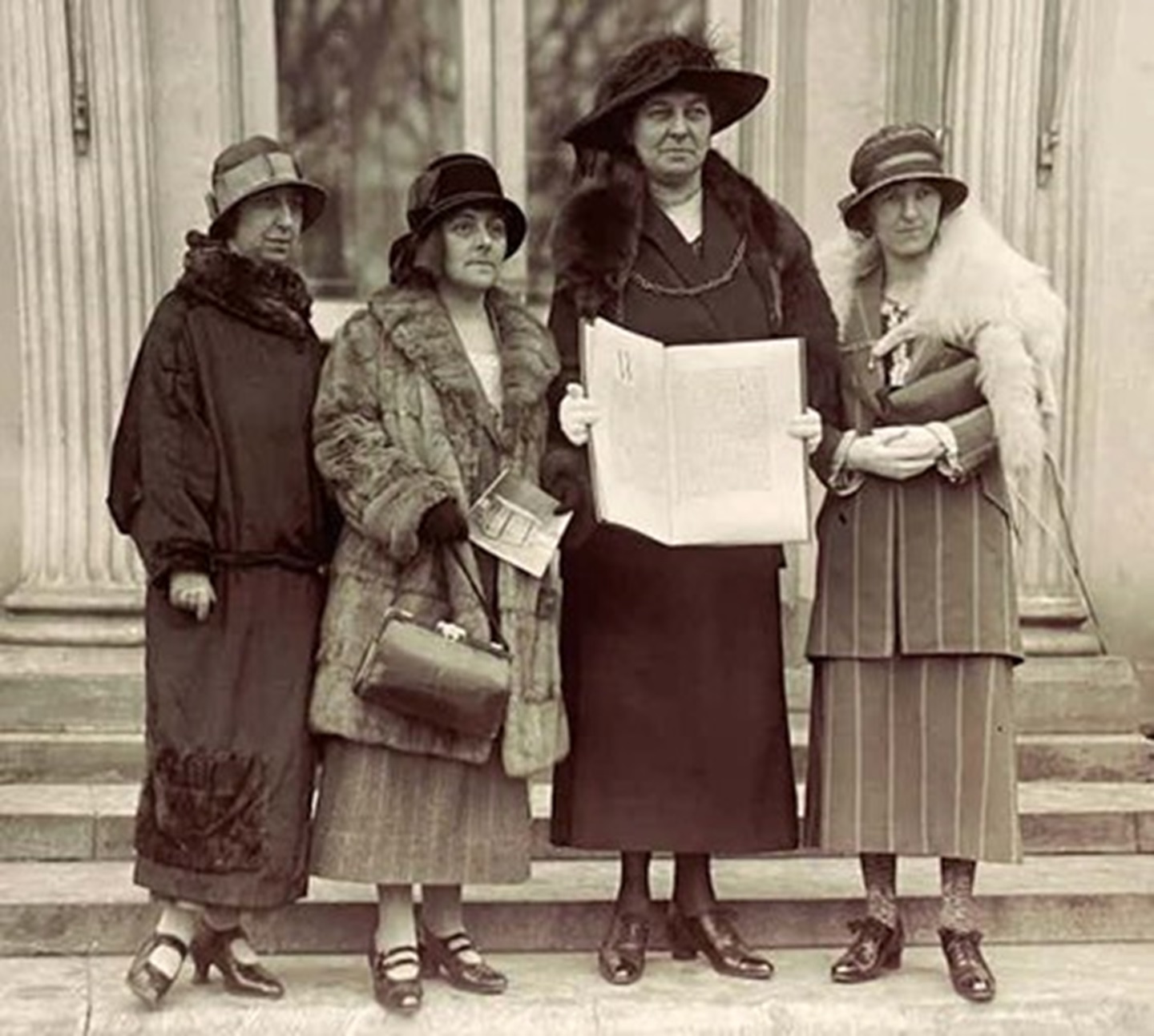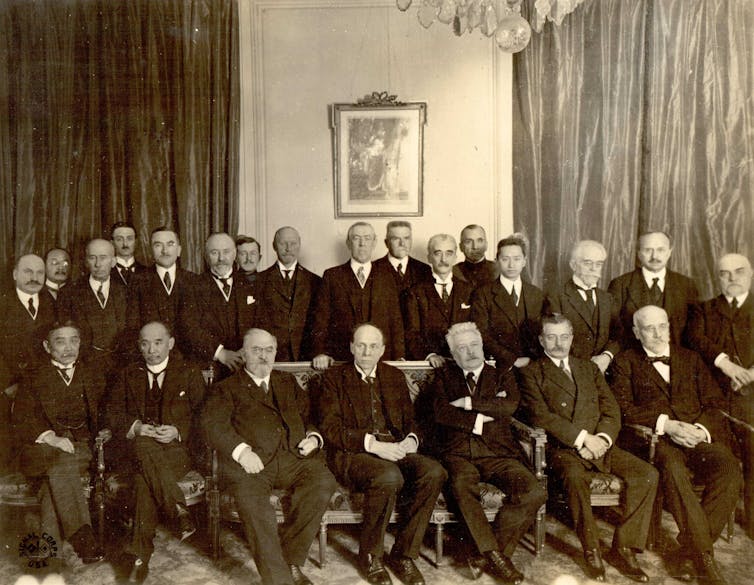A century ago, the women of Wales made an audacious appeal for world peace – this is their story

Annie Hughes Griffiths holds the Welsh women’s petition for peace at the White House on February 21 1924, alongside (l-r) Gladys Thomas, Mary Ellis and Elined Prys. WCIA/Temple of Peace Archives, Author provided (no reuse)
29 May 2024
February 11 1924, on board the RMS Cedric: Saw Statue of Liberty glowing in the sunlight. Bitterly cold wind, bright sunshine. At lunch, a press man came to me and said: ‘Mrs Griffiths, I am from the press.’ ‘I have nothing to say,’ I said. ‘Oh!’ said he, ‘we know your story of the Women of Wales movement, we want only your photos – will you come to the top deck when you have finished?’ So [we] trotted up to the top deck first class, where we found four burly photographers awaiting us.
March 12 1924, Los Angeles: A letter was handed to me as I left the station – an anonymous letter, telling us to get out of the United States.
One hundred years ago, Annie Hughes Griffiths travelled from her native Wales to the US, visiting everywhere from New York and Washington DC to San Francisco and Los Angeles. But while the diary of her trip describes some typical tourist must-sees – Niagara Falls, Grand Canyon, Golden Gate Bridge and Lincoln Memorial – this was no ordinary vacation, and Hughes Griffiths no ordinary tourist.
She was part of a delegation of four Welsh women tasked with delivering what the South Wales Gazette described as a “monster petition” – one which reputedly would have stretched for seven miles if its pages of signatures had been placed end to end. The petition was an appeal for global peace, from the women of Wales to the women of America.
This whirlwind US visit was the culmination of a six-month campaign that had seen more than 400 local organisers go door-to-door collecting signatures in towns and villages throughout Wales. In all, they gathered 390,296 signatures – which would be an impressive achievement even today, when the internet and social media connect us instantly with people around the world. But this was 100 years ago, at a time when cars and landline telephones were still objects of curiosity.
Hughes Griffiths and her fellow peace missionaries (all of whom paid for the trip themselves) presented their petition to America’s leading women’s organisations and later met the US president, Calvin Coolidge, inside the White House. But while many welcomed these pioneering women from across the Atlantic, others – including the anonymous letter writer Hughes Griffiths describes in her diary – were deeply opposed to the idea of the US taking a lead role in international initiatives, even those aimed at preventing war.
Despite the publicity the petition achieved on both sides of the Atlantic at the time – and the creation of lasting institutional and personal networks between Welsh and American peace campaigners – the story of this extraordinary effort has long since faded from our collective memory. It does not appear in history books even in Wales, and nor is it taught in schools.
We are the editors of a new book, Yr Apêl-The Appeal, which tells this forgotten history, thanks to painstaking research by the book’s contributors who combed through the diaries and letters of those women (and some men) who were the driving force behind the peace petition, as well as newspaper accounts and public records from the 1920s.
There were differences between the many thousands of Welsh women who signed the petition: language, religion, political affiliations, and socio-economic circumstances. But these differences were unimportant in comparison to what united them: the dream of a world without war.
Planning the petition
The association of women with the cause of peace was nothing new. It had been the cornerstone of the pre-first world war international women’s peace movement that explicitly linked peace with the expansion of civic rights to women – especially, but not exclusively, the right to vote. The logic was that if women were able to play a larger role in public life and in political decisions, there might be more attention devoted to peaceful means of resolving disputes.
Some 40,000 soldiers from Wales had died in the first world war, while many of their 230,000 compatriots who also fought had returned with life-changing physical injuries and “shell shock” (post-traumatic stress disorder). The war’s devastating effects on Welsh families and communities instilled a widespread determination that such a conflict should never again be permitted.
For some, the answer lay in a personal commitment to pacifism. Others looked to political parties: the Labour party in Wales experienced a surge of support that nearly doubled the number of MPs it sent to Parliament between 1918 and 1922, including several anti-war activists.
At the same time, there was recognition of the pressing need for some kind of institutional means of resolving international disputes – where nations could be brought together to settle their differences by discussions held around a negotiating table, rather than battles in the trenches. The newly established League of Nations held out the hope of providing the necessary furniture for peace.

Created by the Treaty of Versailles that formally brought an end to the first world war, the League of Nations (1920-1946) was envisioned as a practical means of preventing future war. It was greeted with great enthusiasm in Wales, including by David, Gwendoline and Margaret Davies, three siblings with personal experience of the horrors of war – David as an officer, Gwendoline and Margaret as volunteer nurses in a French field hospital.
All believed in the league’s potential to transform global politics. And, thanks to the enormous wealth they had inherited from their industrialist grandfather, David Davies of Llandinam, they could provide practical support for efforts to realise that potential. In 1919, they sponsored the world’s first chair in International Politics at the University College of Wales, Aberystwyth. Three years later, another donation by David Davies (the younger) secured the long-term future of the Welsh branch of the League of Nations Union – then Britain’s largest and most influential civil society organisation dedicated to peace during the interwar period.
This article is republished from The Conversation under a Creative Commons license. To read the full and article click here.



